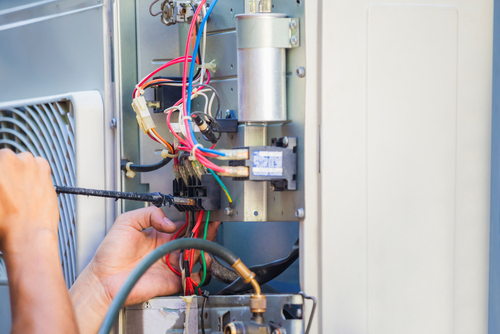Professional assistance in mechanical engineering industry support to address your needs.
Professional assistance in mechanical engineering industry support to address your needs.
Blog Article
Professional Solutions for Electric System Troubleshooting and Repair Work
Effective repairing and repair service of electrical systems call for a systematic strategy, leveraging both advanced analysis tools and skilled knowledge. Usual issues such as circuit overloads and defective electrical wiring need prompt focus, yet the complexities of electrical systems can often cover the hidden problems. Safety protocols are vital, as also small oversights can bring about significant hazards. Comprehending when to involve a professional can make all the distinction in making sure both safety and security and system honesty. As we explore the essential elements of electric troubleshooting, the effects of neglecting these ideal methods end up being increasingly apparent.

Common Electrical Issues
While electrical systems are designed for integrity, they can regularly encounter a range of typical issues that may interrupt performance and safety. One common issue is circuit overload, which occurs when way too many devices attract power from a solitary circuit, leading to tripped breakers or blown merges. technical support for electrical industry. This can not only restrain electrical performance yet additionally present a fire danger
Another constant issue is defective wiring, usually as a result of age, wear, or improper installation. Harmed or torn cords can lead to brief circuits, causing blackouts or electrical shocks. Additionally, loosened connections can create periodic power loss, creating irritating and possibly unsafe scenarios.
Ground faults are an additional issue, especially in wet or moist settings where electrical devices is made use of. These mistakes can cause serious safety dangers, requiring instant attention to make sure correct grounding and circuit security.
Lastly, flickering lights can indicate problems varying from overloaded circuits to defective lights. Determining these common electric issues is vital for maintaining the integrity and safety and security of electric systems, guaranteeing they operate successfully and effectively. Addressing these concerns immediately can prevent more severe problems and enhance general system reliability.
Diagnostic Devices and Techniques
Utilizing exact diagnostic tools and techniques is vital for successfully recognizing and resolving electric system problems. Different instruments facilitate specific analyses, ranging from basic multimeters to innovative oscilloscopes - technical support for electrical industry. Multimeters are basic for measuring voltage, current, and resistance, making it possible for specialists to quickly determine faulty components or connections
Clamp meters are especially beneficial for measuring existing without interrupting the circuit, boosting safety during diagnostics. For more intricate troubleshooting, oscilloscopes allow for the visualization of electrical signals over time, using understandings into waveform anomalies that may indicate underlying issues.
In addition to these tools, infrared thermography is important for detecting overheating components, which can indicate impending failings. Insulation resistance testers further aid in recognizing endangered insulation, important for avoiding electrical dangers.
Strategies such as aesthetic evaluations, continuity tests, and circuit tracing are also indispensable to a reliable diagnostic process. By integrating these devices and methods, specialists can establish a thorough understanding of electric systems, guaranteeing accurate diagnoses and effective repairs. Inevitably, leveraging the best analysis resources not just enhances troubleshooting performance but additionally adds to the longevity and security of electrical installations.
Step-by-Step Troubleshooting Guide

Following, make use of analysis tools such as multimeters and circuit testers to check for connection, voltage, and existing circulation in the circuit. Beginning at the power resource, confirming that it is operational, then map the circuit action by step, checking each component along the method. Paper your findings to preserve quality throughout the process.
As soon as you have actually recognized the damaged component, isolate it from the circuit. Perform needed repair work or substitutes, ensuring that all circuitry and connections are secure. After dealing with the concern, recheck the entire system to confirm that it runs appropriately.
Safety And Security Safety Measures Throughout Repairs
Guaranteeing safety and security during electrical fixings is extremely important to stop accidents and injuries. Prior to beginning any kind of work, it is important to switch off the power supply at the circuit breaker and verify that the circuit is de-energized utilizing a reputable voltage tester. Personal safety devices (PPE), including shielded gloves and security goggles, must be worn to minimize the risk of electric shock and eye injuries.
Utilizing tools with insulated takes care of can additionally boost safety and security. It is additionally vital to avoid working on electric systems in damp or wet conditions, as wetness considerably raises the risk of electric shock.
Safe loosened garments and link back long hair to avoid any complexity with electrical components. Acquaint on your own with the particular electric codes and policies relevant to your location to make sure compliance and safety during the fixing process.
When to Call an Expert
While security precautions are essential for any type of electrical repair, there are scenarios where the complexity or extent of the work requires the proficiency of an expert electrical expert. Home owners must be specifically cautious when handling check out here issues that involve breaker, electrical panels, or the primary power supply. Any type next of signs of electric fires, such as scorched smells or flickering lights, warrant instant expert focus.
Furthermore, if you come across persistent tripping of breaker or frequent electric surges, these might indicate underlying troubles that call for specialized analysis tools and understanding. Projects that necessitate considerable rewiring, installation of brand-new circuits, or links to high-voltage systems should always be delegated qualified electricians, as incorrect handling can result in serious threats.
In addition, regulatory compliance is important in electric work. Professionals are acquainted with local codes and policies, ensuring that all fixings fulfill security criteria.
Final Thought
In final thought, efficient fixing and repair of electric systems call for an organized technique, leveraging advanced diagnostic devices and adherence to safety and security precautions. By recognizing typical electric troubles and using an organized troubleshooting guide, many issues can be fixed successfully.
Report this page